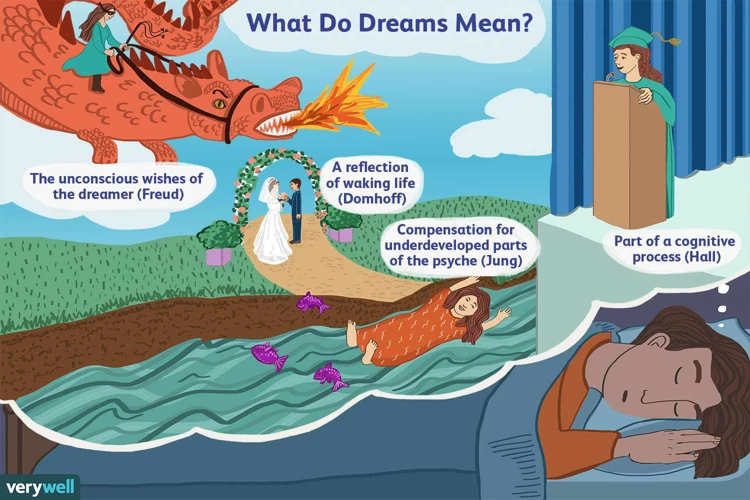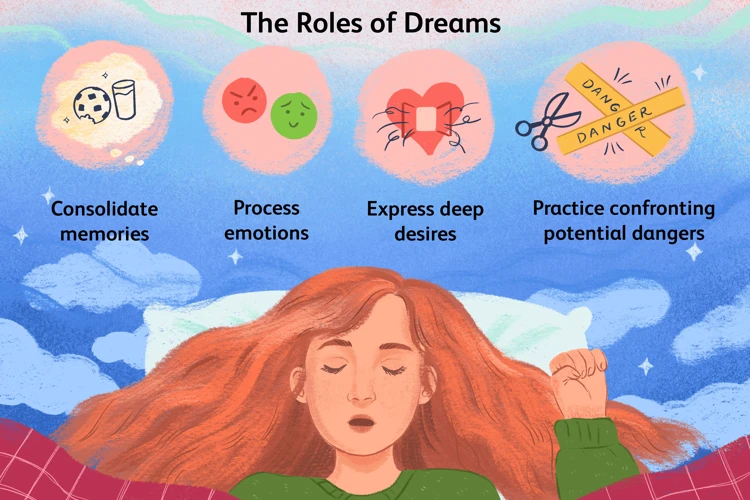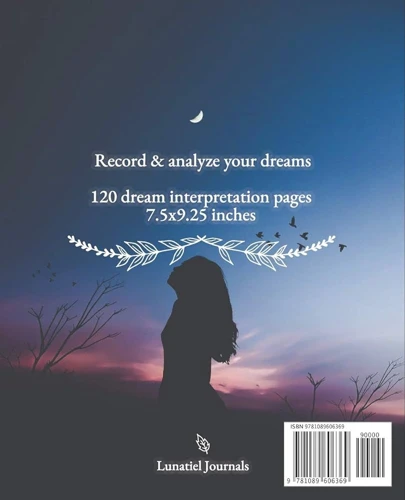It’s a mysterious realm where our deepest desires manifest, nightmares come to life, and our subconscious mind unleashes its boundless creativity – the enigmatic world of dreams. Like a secret code waiting to be deciphered, dreams hold the key to unlocking the hidden meanings and truths of our existence. As we sleep, our minds embark on incredible journeys, filled with ancient symbols, fragmented memories, and inexplicable sensations. In this article, we will unravel the hidden meanings of dreams, exploring their importance, different types, symbolic significance, psychological interpretations, and scientific underpinnings. So, fasten your seatbelts as we dive headfirst into the intriguing depths of the dream realm.
The Importance of Dreams

Dreams play a vital role in our lives, offering a unique window into our subconscious mind. They serve as a gateway to exploration, self-discovery, and understanding. The importance of dreams lies in their ability to provide insights into our deepest desires, fears, and unresolved emotions. They can act as a mirror, reflecting our innermost thoughts and feelings that may be hidden during our waking hours. Additionally, dreams have the power to stimulate creativity, problem-solving abilities, and even provide guidance for important life decisions. By paying attention to our dreams and unraveling their hidden messages, we can gain a deeper understanding of ourselves and our place in the world.
Types of Dreams

Dreams come in various forms and each type offers a unique experience and significance. Lucid dreams are like vivid virtual realities where the dreamer is aware that they are dreaming, granting them the ability to control and manipulate the dream’s events. Nightmares, on the other hand, can be unsettling and distressing, often filled with intense fear or anxiety. These dreams may stem from unresolved traumas or deep-seated fears. Recurring dreams are persistent and recur over time, carrying a message or symbol that the subconscious mind is trying to convey. They often indicate unresolved issues or unresolved emotions that need attention. Whether it’s the exhilarating control of lucid dreams, the unsettling unease of nightmares, or the persistent message of recurring dreams, each type of dream offers valuable insights into our inner workings and deserves exploration and interpretation.
Lucid Dreams
Lucid dreams are a fascinating phenomenon where the dreamer becomes aware that they are dreaming while still in the dream state. It’s like having a front-row seat to a vivid, fantastical movie where you have complete control over your actions and surroundings. In lucid dreams, the dreamer can actively participate in the dream narrative, thereby creating a unique opportunity for exploration and experimentation. Lucid dreaming opens doors to endless possibilities, allowing individuals to overcome fears, practice new skills, and even engage in fantasies that may not be possible in waking life. This heightened state of awareness within dreams offers a thrilling and empowering experience for those lucky enough to encounter it.
Nightmares
Nightmares, unlike pleasant dreams, can leave us startled and anxious upon waking. These disturbing and vivid dreams often involve intense fear, terror, and a sense of impending danger. Nightmares can stem from various sources, including traumatic experiences, unresolved emotions, stress, and anxiety. They may serve as a reflection of our fears, anxieties, and underlying psychological issues that need to be addressed. Some common themes in nightmares include being chased, falling, or being trapped. It is important to recognize and explore the underlying meanings of nightmares, as they can provide valuable insights into our waking lives and help us confront and resolve the underlying issues causing distress.
Some characteristics of nightmares:
– Disturbing and vivid dreams
– Involving fear, terror, and danger
– Linked to traumatic experiences, stress, and anxiety
– Reflecting fears, anxieties, and psychological issues
Recurring Dreams
Recurring dreams are those that occur repeatedly over time, often with similar or identical themes, settings, or events. These dreams have a way of capturing our attention and leaving us with a lingering sense of curiosity. Recurring dreams may indicate unresolved issues or deep-rooted emotions that our subconscious mind is trying to bring to our attention. They can serve as a metaphorical reminder of something we need to address or confront in our waking lives. Some common examples of recurring dreams include being late or unprepared for an important event, falling from a height, being chased, or experiencing the same scenario over and over again. By reflecting on the recurring themes or symbols present in these dreams, we can gain valuable insights into ourselves and our experiences.
Interpreting Dream Symbols

Within the realm of dreams, symbols hold the key to unlocking their hidden meanings and messages. Interpreting dream symbols is like deciphering a cryptic language unique to each individual. While some symbols may have common meanings, such as water representing emotions or doors symbolizing new opportunities, the interpretation of symbols is largely personal. Common dream symbols can be found in various cultures and hold collective significance, while personalized dream symbols are unique to each dreamer based on their personal experiences, beliefs, and emotions. To interpret dream symbols, it is crucial to consider the context, emotions, and personal associations attached to the symbol. With careful introspection and understanding, dream symbols can reveal profound insights and provide guidance for personal growth and self-discovery.
Common Dream Symbols
Common dream symbols often appear across various cultures and can carry universal meanings. These symbols can be categorized into different themes, each with its own significance. Symbols related to animals, such as snakes, birds, or wolves, often represent primal instincts, fears, or guidance. Water-related symbols, like oceans or rivers, often symbolize emotions, unconsciousness, or the flow of life. Objects like keys, doors, or mirrors may signify opportunities, self-reflection, or self-discovery. Flying or falling dreams often symbolize a sense of freedom or loss of control. These are just a few examples of the vast range of common dream symbols, each carrying unique meanings that can be explored and analyzed.
Personalized Dream Symbols
When it comes to dream symbols, there is no one-size-fits-all interpretation. Personalized dream symbols hold unique significance to each individual, as they are deeply influenced by personal experiences, memories, and emotions. For example, while a cat may symbolize independence for one person, it may represent fear or unpredictability for another. To unlock the meaning behind personalized dream symbols, it is crucial to consider the context, emotions, and personal associations attached to them. Keeping a dream journal can be incredibly helpful in identifying recurring symbols and their personalized interpretations. By analyzing patterns and reflecting on the emotions evoked by these symbols, we can gain valuable insight into our subconscious mind’s message.
Psychological Perspective

When it comes to understanding dreams, the psychological perspective is a valuable lens through which we can gain insights. Sigmund Freud, the father of psychoanalysis, believed that dreams were a gateway to our unconscious mind. According to Freud, dreams served as a way for the mind to process repressed desires and unresolved conflicts. In Freudian interpretation, dream symbols were seen as representations of hidden sexual and aggressive impulses. On the other hand, Carl Jung took a more holistic approach, considering dreams as a means of communication between the conscious and unconscious aspects of the mind. Jung believed that dreams contained archetypal symbols and images that could tap into the collective unconscious. This perspective suggests that dreams have a universal meaning that transcends individual experiences. Both Freud and Jung’s theories offer intriguing insights into the psychological significance of dreams, taking us on a journey into the depths of our psyche.
Freudian Interpretation
Sigmund Freud, a renowned psychologist, delved into the realm of dreams and developed a groundbreaking interpretation known as the . According to Freud, dreams are the manifestation of repressed desires and unresolved conflicts from our unconscious mind. He believed that dreams served as a playground for our deepest, often hidden, sexual and aggressive instincts. Freud emphasized the importance of dream analysis in uncovering the hidden meanings behind our dreams, particularly through the exploration of symbols and latent content. Through this interpretation, Freud aimed to bring unconscious desires and conflicts to the surface, allowing individuals to gain insight into their subconscious mind and potentially find resolution to their emotional struggles.
Jung’s Analytical Approach
Jung’s analytical approach to dream interpretation delves into the symbolic and archetypal aspects of dreams. According to Carl Jung, dreams are a gateway to the collective unconscious, a reservoir of shared human experiences and symbolism. In his approach, Jung emphasized the importance of understanding dream symbols within the context of the dreamer’s personal experiences and cultural background. He believed that dreams contain messages from the unconscious mind, aiming to bring forth hidden aspects of ourselves or offer guidance for personal development. Jung developed the concept of archetypes, universal symbols that appear in dreams and represent fundamental human experiences and instincts. By analyzing dream symbols and their underlying archetypal meanings, individuals can gain a deeper understanding of their own psyche and inner conflicts.
Cultural and Symbolic Significance

Dreams hold immense cultural and symbolic significance, shaping beliefs and practices in different societies across the globe. In Native American culture, dreams are seen as a way to communicate with spiritual beings, ancestors, and the natural world. They are regarded as messages from the divine, providing guidance, warnings, and visions of the future. In Eastern traditions, such as Hinduism and Buddhism, dreams are considered a reflection of karma and the state of one’s consciousness. They are seen as opportunities for self-realization and spiritual growth. Dreams also hold symbolic meaning in various cultures, with certain symbols carrying specific connotations. For example, water may represent emotions and purification, while snakes might symbolize transformation or healing. Understanding the cultural and symbolic significance of dreams can offer valuable insights into different belief systems and shed light on the diverse interpretations and meanings behind our nocturnal journeys.
Dreams in Native American Culture
Dreams hold profound significance in Native American culture, where they are believed to be a sacred connection between the physical and spiritual realms. In many Native American tribes, dreams are seen as messages from ancestors, spirits, and even animals. They are seen as valuable sources of guidance, healing, and spiritual growth. Native Americans place great importance on dream interpretation, using it as a means to understand their purpose in life, make important decisions, and seek spiritual guidance. Dreams are often shared within the community, as they are believed to hold collective meaning and wisdom. They serve as a rich tapestry of symbols, visions, and stories that provide cultural preservation and a deeper connection to the spiritual world.
Interpretation in Eastern Traditions
Interpretation of dreams in Eastern traditions holds a significant place in understanding the profound meanings hidden within. In Eastern cultures, dreams are often seen as a divine or spiritual communication with the universe. The interpretation of dreams is deeply rooted in ancient practices such as Chinese, Indian, and Tibetan traditions. These cultures believe that dreams provide valuable insights into one’s karma, energy flow, and spiritual journey. Symbols and imagery in dreams are examined closely, as they are believed to hold intricate messages from the higher realms. Eastern traditions also emphasize the importance of dream interpretation for personal growth, self-reflection, and gaining deeper wisdom. By exploring the symbolic significance of dreams from an Eastern perspective, individuals can unlock profound insights and tap into their spiritual connection with the universe.
The Science Behind Dreams

Behind the veil of mystery, there lies a scientific explanation for the phenomenon of dreams. The science behind dreams reveals the intricate workings of our brain during the sleep cycle. Neuroscience research has shown that dreams occur during the Rapid Eye Movement (REM) stage of sleep, which is characterized by heightened brain activity. During this stage, the brain processes and consolidates memories, emotions, and experiences from the day. It is believed that dreams serve as a way for the brain to make sense of this information and create narratives that we perceive as dreams. Studies have also shown that certain regions of the brain, such as the limbic system and prefrontal cortex, are active during dreaming, contributing to the vividness and emotional intensity of our dream experiences. Through advancements in scientific understanding, we are unraveling the complex tapestry of the dreaming mind, providing valuable insights into the mechanisms behind this fascinating phenomenon.
Brain Activity During Dreams
During dreams, there is a fascinating dance of neural activity happening within our brains. Various regions of the brain become activated and interconnected, leading to a complex web of cognitive processes and sensory experiences. The prefrontal cortex, responsible for logic and decision-making, is less active during dreams, which may explain the surreal and illogical nature of dream content. The amygdala, involved in processing emotions, becomes highly active, contributing to the intense emotions often felt during dreams. The hippocampus, which plays a crucial role in memory formation, consolidates and integrates memories, creating unique dream scenarios. The visual cortex becomes stimulated, giving rise to vivid and lifelike dream imagery. This intricate interplay of brain regions during dreams highlights the dynamic nature of our cognitive processes during sleep.
REM Sleep and Dreams
During REM (Rapid Eye Movement) sleep, the stage of sleep where dreams occur, our brain activity becomes remarkably similar to that of wakefulness. It is during this stage that our most vivid and memorable dreams take place. REM sleep is characterized by the rapid movement of the eyes, increased brain activity, and temporary paralysis of the muscles. This stage of sleep is essential for cognitive function, memory consolidation, and emotional processing. Dreams that occur during REM sleep are often more elaborate, emotional, and immersive. It is believed that REM sleep and dreams play a crucial role in memory formation, emotional regulation, and overall mental well-being. Understanding the connection between REM sleep and dreams can provide valuable insights into the intricate workings of our minds while we sleep.
Recording and Analyzing Dreams

One of the most effective ways to make sense of our dreams is by recording and analyzing them. By keeping a dream journal or using specialized tools, we can capture the details of our dreams as soon as we wake up. Recording dreams allows us to preserve the fleeting memories and intricate imagery before they fade away, enabling us to analyze them later. In a dream journal, we can write down the emotions, symbols, and events we experienced, creating a timeline of our dream landscapes. By reflecting on our dream patterns and themes, we may uncover recurring symbols, conflicts, or messages that offer valuable insights into our subconscious mind. Tools such as dream dictionaries or interpretation apps can also provide guidance on understanding common dream symbols, helping us decode the hidden meanings within our dreams. Whether through pen and paper or digital platforms, the act of recording and analyzing dreams allows us to delve deeper into the enigmatic realms of our psyche, bringing us closer to unraveling the true essence of our dreams.
Dream Journals and Tools
Dream journals are invaluable tools when it comes to recording and analyzing our dreams. Keeping a dream journal allows us to capture the details of our dreams as soon as we wake up, ensuring that we don’t forget them. By documenting our dreams, we can identify patterns, recurring symbols, and themes that provide deeper insights into their meanings. Dream journals can be as simple as a notebook by your bedside or can be digital apps specifically designed for recording dreams. In addition to dream journals, there are other helpful tools available to aid in dream analysis. These include dream dictionaries, which provide interpretations of common dream symbols, and various techniques such as dream mapping and guided imagery exercises, which can help explore the symbolism and emotions behind our dreams. With the help of these tools, we can dive deeper into the rich tapestry of our dreams and unlock their hidden messages.
Reflecting on Patterns and Meanings
When it comes to reflecting on patterns and meanings in our dreams, a systematic approach can help unravel their hidden significance. One effective method is keeping a dream journal, where you record your dreams as soon as you wake up. By documenting your dreams regularly, you can identify recurring symbols, themes, and emotions that may hold deeper meaning. Analyzing these patterns can provide valuable insights into your subconscious mind and help uncover unresolved issues or desires. Additionally, it can be helpful to seek the guidance of a dream expert or therapist who can offer interpretations and facilitate deeper exploration of your dreams. Remember, every dream is unique, and finding meaning requires a patient and curious mindset.
Benefits of Understanding Dreams

Understanding dreams comes with a plethora of benefits that can greatly enhance our lives. One of the key benefits is self-reflection and personal growth. By delving into the meanings of our dreams, we gain valuable insights into our subconscious mind, unraveling hidden thoughts, emotions, and patterns that influence our waking life. This self-reflection allows us to identify areas for personal growth and self-improvement. Furthermore, dreams can serve as a powerful tool for problem-solving and creativity. They often present us with innovative solutions and fresh perspectives on complex issues that we may not have considered in our conscious state. By embracing and understanding our dreams, we unlock the potential to tap into our creativity and approach challenges from a new angle, fostering innovation and ingenuity in various aspects of our lives.
Self-Reflection and Personal Growth
Self-reflection and personal growth are key benefits that can be gained from understanding dreams. Through the analysis of our dreams, we can gain deep insights into our own psyche and innermost thoughts. Dreams often reflect our subconscious desires, fears, and unresolved issues, offering us a unique opportunity for self-reflection. By deciphering the symbolism and messages within our dreams, we can uncover patterns and themes that may be influencing our waking lives. This self-awareness allows us to identify areas of personal growth and work towards healing and transformation. Whether it’s overcoming fears, resolving past traumas, or gaining clarity on life goals, dreams can serve as powerful tools for personal development and self-discovery. By embracing and exploring our dreams, we open the doors to a richer and more fulfilling life.
Problem Solving and Creativity
When it comes to problem-solving and unleashing creativity, dreams can be invaluable allies. During REM sleep, the stage in which most dreaming occurs, our brain engages in complex processes that can help us tackle real-life challenges. In our dreams, we may encounter situations that mirror the problems we are facing, allowing us to explore different scenarios and potential solutions without the limitations of reality. Dreams have the ability to spark creative inspiration, giving rise to innovative ideas and artistic breakthroughs. By paying attention to the symbols, emotions, and narratives within our dreams, we can tap into a wellspring of creative potential and gain fresh perspectives on the challenges we face in our waking lives. Embracing the problem-solving and creative power of dreams can lead to ingenious breakthroughs and new pathways of thinking.
Common Dream Themes

Our dreams are filled with an array of fascinating and often perplexing themes that captivate our minds. Common dream themes encompass a wide range of experiences and emotions, each holding its own symbolic significance. One such theme is the sensation of falling or flying dreams, which can symbolize a desire for freedom, liberation, or a sense of control over one’s life. Another common theme is the teeth falling out dreams, which can represent feelings of insecurity, loss, or a fear of aging. Additionally, the being chased dreams symbolize avoidance, a need for escape, or unresolved conflicts. These recurring dream themes provide us with valuable insights into our subconscious mind and can serve as a compass for self-reflection and personal growth. By deciphering the hidden meanings behind these dream themes, we can unlock a wealth of understanding about ourselves and our deepest desires.
Falling or Flying Dreams
Falling or Flying Dreams: Falling or flying dreams are among the most common and intriguing dream themes experienced by many individuals. In falling dreams, the sensation of uncontrollable descent can evoke a rush of fear or panic, leaving us with a feeling of vulnerability. However, some interpret falling dreams as a symbol of letting go, surrendering control, or embracing change in waking life. On the other hand, flying dreams often evoke a sense of freedom, empowerment, and liberation from earthly limitations. They can symbolize personal growth, ambition, and the desire to rise above challenges. Whether we find ourselves plummeting from the sky or soaring through the clouds, falling or flying dreams are a fascinating reflection of our subconscious desires, fears, and aspirations.
Teeth Falling Out Dreams
– Teeth falling out dreams are one of the most common and perplexing dream themes that individuals experience.
– These dreams can evoke a sense of vulnerability, anxiety, and loss of control.
– Symbolically, teeth falling out dreams can represent feelings of insecurity, powerlessness, or fear of aging and losing attractiveness.
– Some experts interpret these dreams as a reflection of concerns about communication issues or fear of saying something wrong.
– The specific context of the dream, such as the condition of the teeth or the presence of pain, can provide additional clues to the underlying meaning.
– It is important to note that dream interpretations are highly personal, and the significance of teeth falling out dreams may vary from individual to individual.
– Exploring the emotions and associations surrounding these dreams can provide valuable insights into areas of life that may need attention or resolution.
Being Chased Dreams
One of the most common and unsettling dream themes is being chased. Being chased dreams often evoke feelings of fear, anxiety, and a sense of being pursued or threatened. The act of being chased in a dream can symbolize a variety of underlying emotions or situations in our waking life. It may represent a sense of being overwhelmed by responsibilities, pressure, or unresolved conflicts. Alternatively, being chased can also signify a desire to escape from something or someone in our lives. In these dreams, it is essential to pay attention to the identity of the pursuer and the context of the chase, as they can offer valuable insights into the specific areas of our lives that require attention or resolution. Exploring the symbolism and emotions associated with being chased in dreams can help us uncover hidden fears, confront challenges, and regain a sense of control in our waking lives.
Expert Insights and Interpretations

When it comes to exploring the complexities of dreams, experts from various fields offer their unique insights and interpretations. Psychologists suggest that dreams serve as a window into our subconscious mind, revealing hidden desires and unresolved conflicts. Sigmund Freud, a prominent figure in dream analysis, believed that dreams were the disguised fulfillment of repressed wishes. He emphasized the importance of dream symbols and their connection to our unconscious desires. On the other hand, Carl Jung took a more symbolic approach, exploring the collective unconscious and archetypes present in dreams. Other experts, such as neuroscientists, study the physiological aspects of dreaming, examining brain activity during REM sleep to understand the neural processes associated with dreams. While interpretations may vary, these expert insights help shed light on the multifaceted nature of dreams and the profound impact they have on our psyche.
Dreams and Your Subconscious Mind
When we delve into the realm of dreams, we come face to face with the intricate workings of our subconscious mind. Our dreams act as a channel through which our deepest thoughts, desires, and emotions are revealed. They provide a direct link to the unconscious aspect of our psyche, which often remains hidden during our waking hours. Dreams can bring forth memories, fears, and unresolved issues, allowing us to confront and process them in a symbolic and metaphorical way. They serve as a bridge between our conscious and unconscious selves, offering glimpses into the underlying motivations and patterns that shape our behavior. Exploring and deciphering these dream messages can offer profound insights into our true selves and facilitate personal growth and self-awareness. From the surreal landscapes to the cryptic symbols, our dreams serve as a testament to the richness and complexity of our subconscious mind.
Conclusion
In conclusion, dreams are a fascinating and integral part of the human experience. With their hidden meanings, they offer us a glimpse into the depths of our subconscious mind. Through various types of dreams and the interpretation of dream symbols, we can gain valuable insights into our emotions, desires, and personal growth. Whether viewed from a psychological, cultural, or scientific perspective, dreams hold immense significance. By recording and analyzing our dreams, we can unlock their treasures and harness their power for self-reflection, problem-solving, and creative inspiration. So, embrace the mysteries of the dream realm, for within its depths lies a world of endless possibilities and profound revelations.
Frequently Asked Questions
1. Can dreams predict the future?
While some people claim to have had prophetic dreams, the scientific community remains skeptical. Dreams are believed to be a reflection of our subconscious thoughts and emotions rather than a reliable predictor of the future.
2. Why do we forget most of our dreams?
Forgetting dreams is a common occurrence due to the way our memory functions during sleep. Dream memories are stored in short-term memory, which is easily forgotten upon waking. Factors such as distractions, lack of significance, and the brain’s natural process of filtering out irrelevant information contribute to dream amnesia.
3. Can anyone learn to have lucid dreams?
While some individuals are natural lucid dreamers, most people can learn techniques to increase the likelihood of experiencing lucidity during dreams. Practices such as reality checks, keeping dream journals, and practicing mindfulness can help cultivate lucid dreaming abilities.
4. Do nightmares serve a purpose?
Nightmares, although unpleasant, can serve as important wake-up calls for our emotional well-being. They allow us to confront and process fears, anxieties, and unresolved traumas. Nightmares also provide an opportunity for personal growth and self-reflection.
5. Can you control your dreams?
Controlling dreams, known as lucid dreaming, is possible for some individuals. With practice, techniques such as reality testing, visualization, and meditation can increase the likelihood of becoming aware within the dream state and exerting some control over the dream narrative.
6. Do all dreams have meanings?
Not all dreams have specific meanings. Some dreams may simply be a result of random brain activity or influenced by recent experiences. However, many dreams carry symbolic significance and can offer insights into our unconscious thoughts and emotions.
7. Is it possible to interpret someone else’s dreams?
Interpreting someone else’s dreams can be challenging since dreams are highly personal and influenced by individual experiences and emotions. While general symbolism and archetypes can provide a starting point, it is best to approach dream interpretation with caution and respect for the dreamer’s unique perspective.
8. Can recurring dreams be significant?
Recurring dreams often hold valuable insights and messages. They are believed to represent unresolved issues, persistent emotions, or recurring patterns in our waking lives that need attention and resolution.
9. How do dreams influence our emotions upon waking up?
Upon waking, dreams can have a lingering emotional impact, influencing our mood and state of mind. Vivid dreams can evoke emotions such as joy, fear, sadness, or curiosity, which may carry over into our waking hours.
10. Are there cultural variations in dream interpretation?
Absolutely! Dream interpretation varies across cultures and can be influenced by societal beliefs, folklore, and religious traditions. Different cultures assign unique meanings and symbolism to dream elements, highlighting the rich diversity of dream interpretation worldwide.


